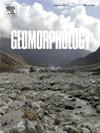Investigating cost-effective single-beam survey configurations for accurate river bathymetry construction
IF 3.1
2区 地球科学
Q2 GEOGRAPHY, PHYSICAL
引用次数: 0
Abstract
River bathymetry is needed to accurately simulate river hydrodynamics. River bathymetric data are typically collected through boat-mounted single- or multi-beam echosounder surveys. Detailed bathymetric data from multibeam surveys may exceed the requirements of standard river hydraulic models (1D and 2D). Compared to data-intensive but expensive multibeam surveys, single-beam surveys are cost-effective. Single-beam surveys can sufficiently inform river simulations when coupled with specific preprocessing and interpolation techniques. This study contrasts two survey patterns, including the commonly used but under-studied zigzag surveys, against the traditional cross-sectional surveys. Linear and anisotropic Kriging interpolations, two widely used methods, are applied to construct bathymetry mesh from different survey configurations. Results from this study highlight efficient survey configurations for both cross-sectional and zigzag patterns, balancing accuracy and cost. Notably, zigzag surveys approach the efficacy of cross-sectional surveys when spaced below a certain threshold, but Kriging interpolation shows diminished performance with sparse zigzag surveys. The findings from this study bridge gaps in previous research by offering nuanced comparisons between survey configurations and interpolations. This study offers a comparative analysis to guide more effective planning and utilization of single-beam surveys, without advocating for specific survey patterns or interpolation techniques.
研究具有成本效益的单梁测量配置,以实现精确的河流水深测量
为了准确地模拟河流的水动力,需要进行河流测深。河流水深数据通常是通过船载单波束或多波束回声测深仪采集的。多波束测量的详细水深数据可能超出标准河流水力模型(1D和2D)的要求。与数据密集但昂贵的多波束测量相比,单波束测量具有成本效益。当与特定的预处理和插值技术相结合时,单光束测量可以充分地为河流模拟提供信息。本研究对比了两种调查模式,包括常用但研究不足的之字形调查和传统的横断面调查。线性克里格插值和各向异性克里格插值是两种广泛使用的方法,用于在不同测量配置下构建测深网格。这项研究的结果强调了横截面和之字形模式的有效测量配置,平衡了准确性和成本。值得注意的是,当间隔低于一定阈值时,之字形调查接近横断面调查的效果,但克里格插值显示,稀疏之字形调查的性能下降。这项研究的发现通过提供调查配置和插值之间的细微比较,弥补了先前研究的空白。本研究提供了比较分析,以指导更有效地规划和利用单波束测量,而不提倡特定的测量模式或插值技术。
本文章由计算机程序翻译,如有差异,请以英文原文为准。
求助全文
约1分钟内获得全文
求助全文
来源期刊

Geomorphology
地学-地球科学综合
CiteScore
8.00
自引率
10.30%
发文量
309
审稿时长
3.4 months
期刊介绍:
Our journal''s scope includes geomorphic themes of: tectonics and regional structure; glacial processes and landforms; fluvial sequences, Quaternary environmental change and dating; fluvial processes and landforms; mass movement, slopes and periglacial processes; hillslopes and soil erosion; weathering, karst and soils; aeolian processes and landforms, coastal dunes and arid environments; coastal and marine processes, estuaries and lakes; modelling, theoretical and quantitative geomorphology; DEM, GIS and remote sensing methods and applications; hazards, applied and planetary geomorphology; and volcanics.
 求助内容:
求助内容: 应助结果提醒方式:
应助结果提醒方式:


